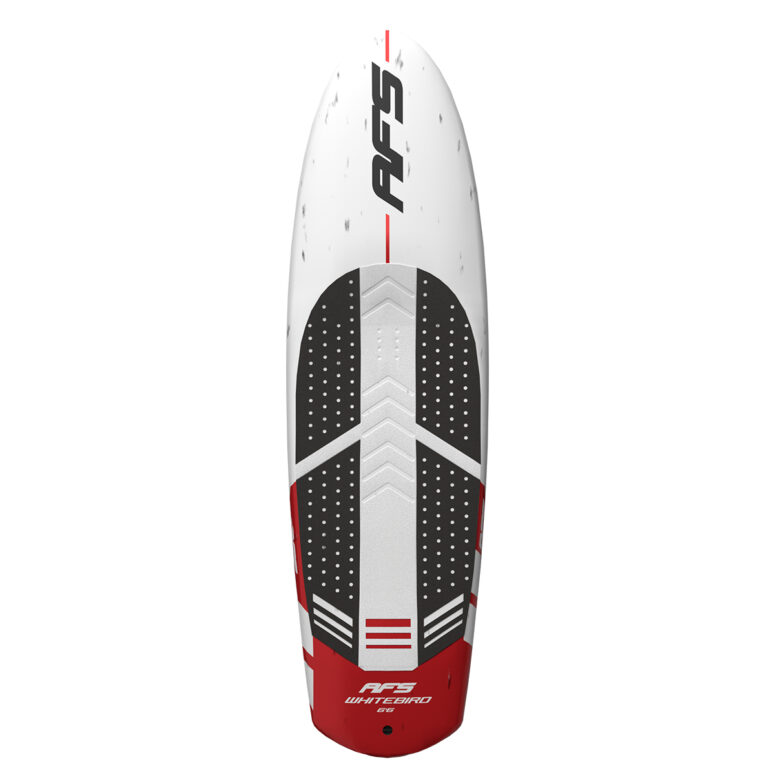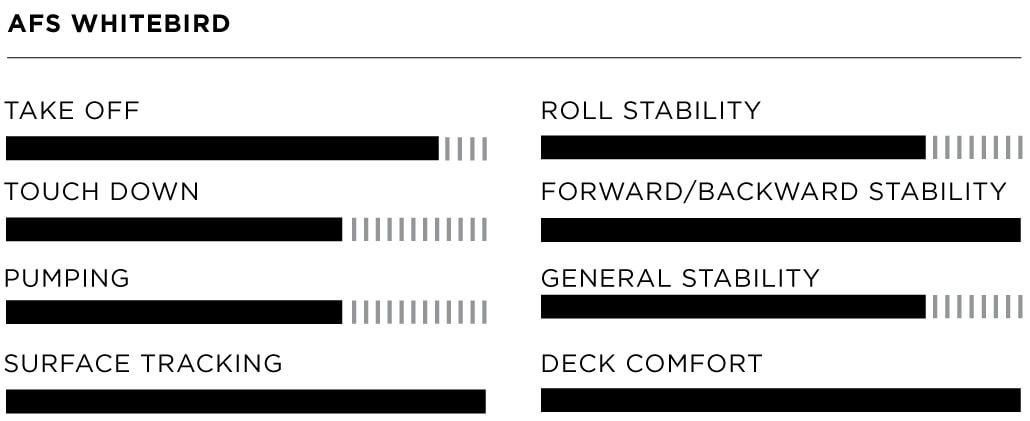

When you purchase gear through links on our site, we may earn a small commission. Here’s why you can trust our tests and our affiliate partner.

AFS (Alien Foil Systems) released the Blackbird some time back which is an extremely high-end, European-produced, no compromises carbon fiber construction which has performed well in the downwind scene with some unique design features. To complement this in terms of price and accessibility, AFS have now released the Whitebird which inherits some of the DNA and pedigree from the Blackbird and presents it in a far more affordable glass construction. Now available in five sizes ranging from 5’8 to 8’2, in volumes from 85 to 145 in 15l increments respectively, this is an expansive range which will cater for a broad spectrum of rider weights and usage intentions, which is all the more important if someone has downwind ambitions.
Construction is full glass with PVC sandwich and it’s manufactured in Tunisia, so robust enough for a big board in a potentially windy situation in the car park. A vent screw sits just in front of the deck for travel, important for a glass board. We were expecting it to feel a little heavy having been on so many full carbon boards of late, but in reality, the 115l weighed in at six and a half kilos, which is extremely competitive.
Shape-wise, it’s a unique and feature-rich affair with a mixture of influences. First off the deck is recessed heavily, particularly relative to the nose which has that classic SUP race board domed affair. The deck pad ramps gently into this nose section and provides a great place to center your front foot on, helping you really lay down some powerful paddle strokes from a stable position. The rear of the deck is flatter, promoting good water shedding if the deck becomes engulfed. A small well-placed hump in the EVA for foot placement at the back of the pad is a welcome feature if your feet drift too far to the rear of the board. There’s no foot strap inserts, which we think on a board this length is the right call, as you need to move around to get the most from it. We’d start paddling in with our weight at the front on the ramp, and then step back over the foil on takeoff to get into a surf stance, and balance the nose weight for pumping.
The hull shape has a lot going on, with a fluted, inverted bell-shaped rail providing passive width and stability when stationary or sub planing; as the board planes and raises this narrows into a harsher edged teardrop at the rear and releases very cleanly. It’s almost like the board has two outlines, a squarer one with the stability that comes with that for sub planing, and a performance DW shape blend-in for as soon as the board has movement. Most of the rocker is centered in the front of the board, with the rear two thirds being relatively flat, again promoting that all important release.
We tested the 115l version at 90kgs, which was perfect for some lightwind full flotation winging and more than enough volume for some SUP foil. Dimensionally, we think AFS have hit the jackpot for a multipurpose board in terms of balancing length and width. The board seems to offer innate stability and decent enough forward speed to get going on smallish lumps SUP foiling. With a wing the board releases early as you’d expect and the foil box position seems to sit far enough forward and not feel too nose heavy which is critical for foot swaps and transitions.
AFS have done a sterling job with the Whitebird, making a well-priced downwind board that will render what’s normally one of the more high punching purchases a foiler will make all the more palatable, and undoubtedly giving more people access to the discipline. What’s even better is that in performance terms glass vs carbon doesn’t feel like a massive compromise, particularly for those at the start of their DW journey.
